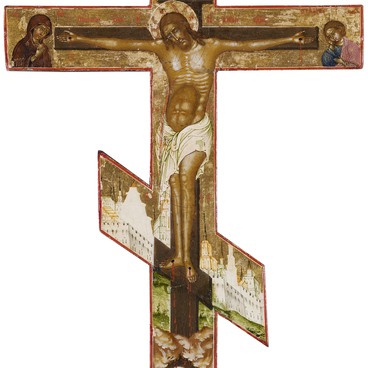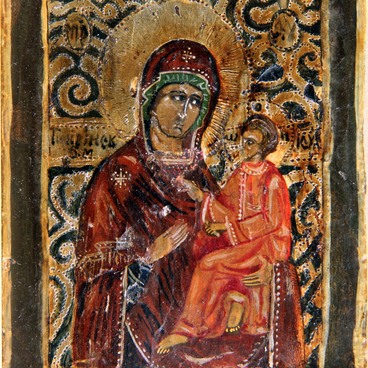The icon ‘Our Lady of Tolga’ belongs to the type of ‘Eleusa’ or ‘Tenderness.’ In such icons, the Mother of God holds the infant Jesus in her arms, and he is nestled against her cheek. The Eleusa of Tolga is special because Jesus is depicted walking on his mother’s knees.
The most ancient “Theotokos of Tolga” in Russia dates back to the 13th century, it was then called the Big Throne icon, and “of Tolga” was added later. It is not known exactly who painted the icon, however, most researchers believe that it is of the Yaroslavl origin. The Holy Virgin was depicted in full growth, enthroned. Today, this icon is kept in the State Tretyakov Gallery.
In the 14th century, another version of the icon appeared, the manifested Virgin of Tolga. According to the legend, it was not painted: the icon was manifested to Trifon, the bishop of Rostov and Yaroslavl, at the mouth of the Tolga River near Yaroslavl. At night, the bishop saw a pillar of light on the opposite bank of the Volga and a fantastic bridge leading to it. In the morning, an icon was discovered at this place. Unlike the Big Throne icon, this icon depicted the Virgin waist-high. Bishop Trifon ordered the construction of a church on the place of manifestation, and later founded the Tolga Monastery of the Presentation of the Virgin.
The most ancient “Theotokos of Tolga” in Russia dates back to the 13th century, it was then called the Big Throne icon, and “of Tolga” was added later. It is not known exactly who painted the icon, however, most researchers believe that it is of the Yaroslavl origin. The Holy Virgin was depicted in full growth, enthroned. Today, this icon is kept in the State Tretyakov Gallery.
In the 14th century, another version of the icon appeared, the manifested Virgin of Tolga. According to the legend, it was not painted: the icon was manifested to Trifon, the bishop of Rostov and Yaroslavl, at the mouth of the Tolga River near Yaroslavl. At night, the bishop saw a pillar of light on the opposite bank of the Volga and a fantastic bridge leading to it. In the morning, an icon was discovered at this place. Unlike the Big Throne icon, this icon depicted the Virgin waist-high. Bishop Trifon ordered the construction of a church on the place of manifestation, and later founded the Tolga Monastery of the Presentation of the Virgin.

